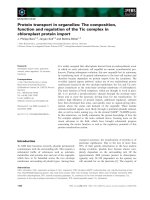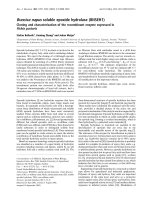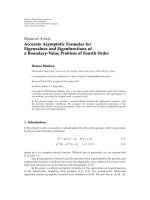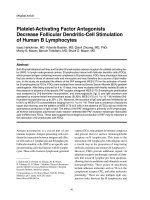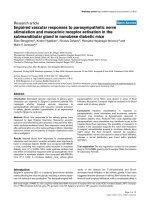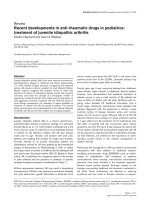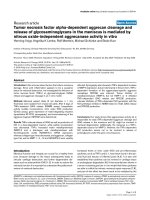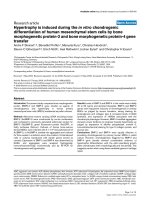Báo cáo y học: "andidemia on presentation to the hospital: development and validation of a risk score" pptx
Bạn đang xem bản rút gọn của tài liệu. Xem và tải ngay bản đầy đủ của tài liệu tại đây (276.42 KB, 10 trang )
Open Access
Available online />Page 1 of 10
(page number not for citation purposes)
Vol 13 No 5
Research
Candidemia on presentation to the hospital: development and
validation of a risk score
Andrew F Shorr
1
, Ying P Tabak
2
, Richard S Johannes
2,3
, Xiaowu Sun
2
, James Spalding
4
and
Marin H Kollef
5
1
Pulmonary and Critical Care Medicine Service, Washington Hospital Center, Washington, DC 20010, USA
2
Clinical Research, MedMined™ Services, CareFusion, 400 Nickerson Road, Marlborough, MA 01752, USA
3
Division of Gastroenterology, Harvard Medical School and Brigham and Women's Hospital, Boston, MA 02115, USA
4
Health Economics & Outcomes Research, Astellas Pharma US Inc., Three Parkway North, Deerfield, IL 60015, USA
5
Pulmonary and Critical Care Division, Washington University School of Medicine, 660 South Euclid Ave, St. Louis, MO 63110, USA
Corresponding author: Andrew F Shorr,
Received: 4 Jun 2009 Revisions requested: 7 Jul 2009 Revisions received: 26 Aug 2009 Accepted: 29 Sep 2009 Published: 29 Sep 2009
Critical Care 2009, 13:R156 (doi:10.1186/cc8110)
This article is online at: />© 2009 Shorr et al.; licensee BioMed Central Ltd.
This is an open access article distributed under the terms of the Creative Commons Attribution License ( />),
which permits unrestricted use, distribution, and reproduction in any medium, provided the original work is properly cited.
Abstract
Introduction Candidemia results in substantial morbidity and
mortality, especially if initial antifungal therapy is delayed or is
inappropriate; however, candidemia is difficult to diagnose
because of its nonspecific presentation.
Methods To develop a risk score for identifying hospitalized
patients with candidemia, we performed a retrospective analysis
of a large database of 176 acute-care hospitals in the United
States. We studied 64,019 patients with bloodstream infection
(BSI) on presentation from 2000 through 2005 (derivation
cohort) and 24,685 from 2006 to 2007 (validation cohort). We
used recursive partitioning (RPART) to identify the best
discriminators for Candida as the cause of BSI. We compared
three sets of models (equal-weight, unequal-weight, vs full
model with additional variables from logistic regression model)
for sensitivity analysis.
Results The RPART identified 6 variables as the best
discriminators: age < 65 years, temperature 98°F or severe
altered mental status, cachexia, previous hospitalization within
30 days, admitted from other healthcare facility, and need for
mechanical ventilation. The prevalence for patients presented
with 0 through 6 risk factors in the derivation cohort was 28.7%,
38.8%, 21.8%, 8.3%, 2.1%, 0.3%, and < 0.1% respectively.
The corresponding candidemia rates were 0.4% (69/18,355),
0.8% (196/24,811), 1.6% (229/13,984), 3.2% (168/5,330),
4.2% (58/1,371), 9.6% (15/157), and 27.3% (3/11)
respectively (P < 0.0001). Findings were similar in the validation
cohort (P < 0.0001). The equal-weight risk score model, which
signed 1 point to each risk factor, yielded good discrimination in
both cohorts with areas under the receiver operating curve
(AUROCs) of 0.70 versus 0.71 (derivation versus validation).
AUROC values were similar for the unequal-weight model,
which signed different weight to each risk factor based on
multivariable logistic regression coefficient, (AUROCs, 0.70-
0.72). Both equal-weight and unequal-weight models were well
calibrated (all Hosmer-Lemshow P > 0.10, indicating predicted
and observed candidemia rates did not differ significant across
the 7 risk stratus). The full model with 16 risk factors had slightly
higher AUROCs (0.74 versus 0.73 for derivation versus
validation); however, 7 variables were no longer significant in the
recalibrated model for the validation cohort, indicating that the
additional items did not materially enhance the model.
Conclusions A simple equal-weight risk score differentiated
patients' risk for candidemia in a graded fashion upon hospital
presentation.
AMS: altered mental status; AUROC: area under the receiver operating curve; BSI: bloodstream infection; BUN: blood urea nitrogen; GCS: Glasgow
Coma Scale; ICD-9-CM: International Classification of Diseases, Ninth Revision, Clinical Modification; NPV: negative predictive value; RPART: recur-
sive partition.
Critical Care Vol 13 No 5 Shorr et al.
Page 2 of 10
(page number not for citation purposes)
Introduction
Candidemia represents the fourth most common type of hos-
pital-acquired bloodstream infection (BSI) [1-3]. More impor-
tantly, candidemia results in substantial morbidity [4-8] and
mortality [7-10], especially if initial antifungal therapy is
delayed or is not appropriate [5,11,12]. Delaying therapy by as
little as 12 hours after obtaining a blood culture can double the
risk of death [11]. Therefore, prompt initiation of antifungal
therapy is a key determinant of outcome. Complicating efforts
to identify subjects at risk for candidemia is the expansion of
healthcare delivery beyond the hospital and the evolving rec-
ognition of distinct healthcare-associated infection syndromes
[13-15], Candida may now represent a cause of BSI in
patients presenting to the hospital [8].
Given the need to ensure appropriate and timely antifungal
therapy and to optimally separate patients at low risk for can-
didemia from those at high risk, some form of risk stratification
for candidemia becomes imperative. This is particularly true for
those with candidemia on admission to the hospital because
clinicians rarely consider this diagnosis in this setting. The
nonspecific signs and symptoms of candidemia further frus-
trate efforts at early patient identification [16]. Although
biomarkers such as (13)--
D-glucan are being investigated
[17], they are not likely to prove useful in patients presenting
to the hospital. The traditional approach to assessing the prob-
ability of Candida as a cause of nosocomial BSI has relied
upon assessing the number and type of risk factors (e.g., cor-
ticosteroid therapy, total parenteral nutrition); however, this
strategy has proven to have little utility in critically ill patients
and proposed schema for risk stratification have yet to be well
validated.
We hypothesized that, despite frustration with clinical risk
stratification paradigms for inpatients, assessment of select
characteristics could identify patients presenting to the hospi-
tal who are at heightened risk for candidemia. We further the-
orized that these select characteristics could be used to
develop a prediction rule to indicate which patients are likely
to have BSI due to Candida as opposed to a bacterial patho-
gen.
Materials and methods
Design
To develop a clinical risk score for identifying patients with BSI
likely to be caused by Candida spp. upon hospital presenta-
tion, we performed a retrospective analysis of patients dis-
charged from 176 acute-care hospitals in the United States
from 2000 to 2005. We validated the risk score with dis-
charge data from the same hospitals from 2006 to 2007.
Data
We used the CareFusion Outcomes Research Database
(Clinical Research Services, CareFusion, Marlborough, MA,
USA), which has been described previously [14,15,18-22].
The database comprises acute-care admissions at participat-
ing hospitals, including electronically imported or manually
abstracted demographic, clinical (e.g., comorbidities, vital
signs, laboratory values, other clinical findings), and adminis-
trative data (e.g., diagnosis). The underlying data for this study
are a limited data set with all patient specific information ano-
nymized. This study was reviewed and approved by the New
England Institutional Review Board/Human Subjects
Research Committee (Wellesley, MA, USA). It was conducted
in compliance with US federal regulations, Health Insurance
Portability and Accountability Act, and the Helsinki Declara-
tion.
The outcome for deriving the risk score was BSI due to Can-
dida spp. as defined by the presence of a blood culture posi-
tive for Candida, and a concomitant primary or secondary
diagnostic code (International Classification of Diseases,
Ninth Revision, Clinical Modification (ICD-9-CM)) indicative of
candidemia. We required that blood samples had been drawn
within one day before or within two days after hospital admis-
sion. This database undergoes multiple quality assurance
assessments with periodic data auditing. In order to limit cod-
ing bias we require concomitant presence of an ICD-9 code
for candidemia and a positive blood culture. We did not
explore other forms of invasive candidiasis.
Variables
Candidate variables were selected a priori based on their bio-
logic plausibility of explaining risk for candidemia. Specifically,
we explored demographic factors (age, gender), vital signs,
mental status, laboratory test results, and underlying comorbid
conditions. Vital signs included pulse, blood pressure, temper-
ature, and respiratory rate. Altered mental status (AMS) was
defined by a Glasgow Coma Scale (GCS) score of 10 to 14
or disoriented/lethargy (mild AMS); GCS 5 to 9 (moderate
AMS); GCS less than 5 or a designation of 'coma' as charted
by a physician (severe AMS). Laboratory testing included
serum albumin; blood urea nitrogen (BUN); creatinine;
sodium; potassium; glucose; hemoglobin; white blood cell
count; and other routine chemistry, hematology, blood gas,
and metabolic results. Comorbid conditions included cachexia
(ICD-9 secondary diagnosis code), history of malignancy, dia-
betes, chronic heart failure, and other chronic conditions
abstracted through chart review or secondary ICD-9 diagnos-
tic codes. In addition, we explored variables pertinent to can-
didemia and were available in the data base, such as
hemodialysis, immunosuppressive medication, previous hospi-
talization within 30 days, transfer from another healthcare facil-
ity, and mechanical ventilation on admission. Certain patient
characteristics were not available in this database. For exam-
ple, utilization of parenteral nutrition outside the hospital and
prior antibiotic exposure are not recorded in this database.
Vital signs and other patient-specific characteristics were
obtained within one day of admission. For each vital sign and
laboratory test result, we used the worst value obtained in the
Available online />Page 3 of 10
(page number not for citation purposes)
emergency department or, if not available, on the day of admis-
sion.
Risk score development
To identify risk factors that optimally separate patients at low
risk for candidemia from those at high risk, we used a recursive
partition (RPART) approach [23]. Also referred to as classifi-
cation and regression tree analysis [24], RPART has been
used to derive prediction rules for acute chest pain [25], heart
failure [26], and other conditions [27,28]. RPART first identi-
fies the variable with the highest discrimination for the out-
come of interest (node) and then repeats the process to
partition subsequent nodes. RPART yields a tree-like algo-
rithm with numerous nodes. To further improve ease of use, we
simplified the algorithm based on the number of risk factors
present, giving equal weight (one point) to each risk factor
identified in by the RPART (equal-weight risk score).
Risk score validation
To validate the model, we applied the derived risk score to
patients in the validation cohort. We compared the between-
cohort distribution of candidemia prevalence by risk score
strata for the validation cohort with that from the derivation
cohort and performed the Cochrane-Armitage test to assess
trend [29]. We used the area under the receiver operating
curve (AUROC) to assess the discrimination of the model and
Hosmer-Lemshow test to assess model calibration. A higher
value for the Hosmer-Lemshow test indicates better model fit.
Sensitivity analysis
Using AUROC and Hosmer-Lemshow goodness-of-fit statis-
tics, we compared the discrimination and calibration of the
simpler versus more complex models. Specifically, we fit three
sets of logistic regression models. The first was the equal-
weight risk-score model, which was a univariate logistic
regression model using a single continuous variable of the
number of risk factors present (ranging from 0 to 6). This
model gave the same weight for each risk factor present. The
second was the unequal-weight risk factor model, which was
a multivariable logistic regression model using each of the
same variables in the equal-weight risk score as covariates.
The unequal weight model assigned different weights for each
variable per multivariable logistic regression coefficients. The
third model was the full risk factor model, which was gener-
ated from a stepwise multivariable logistic regression analysis
with additional variables retained in the model that were signif-
icant (P < 0.05).
Statistical analyses were performed using Statistical Analysis
Software (SAS, version 9.01; SAS Institute Inc., Cary, NC,
USA). Two-sided P values < 0.05 were considered statisti-
cally significant.
Results
Baseline characteristics of derivation and validation
cohorts
The derivation cohort included 64,019 admissions and the val-
idation cohort included 24,685 (Table 1) [see Additional data
file 1]. Many between-cohort differences in demographics,
laboratory findings, vital signs, comorbidities, and other varia-
bles were statistically significant. For example, the derivation
cohort had a smaller proportion of patients aged 64 years or
younger, smaller proportion of men, and higher in-hospital
mortality. Approximately 10% of patients needed mechanical
ventilation on admission, including 9.2% of those in the deriva-
tion cohort and 10.9% of those in the validation cohort. Among
patients needing mechanical ventilation, candidemia occurred
in 2.3% of those in the derivation cohort and in 3.1% of those
in the validation cohort (Table 2) [see Additional data file 2].
Derivation and validation of candidemia risk score
Univariate analysis revealed that the following variables were
associated with candidemia: age younger than 65 years;
cachexia; deranged albumin, arterial pH, and electrolytes; tem-
perature of 98°F or less, or severe altered mental status; pre-
vious hospitalization within 30 days; admitted from other
healthcare facility; and mechanical ventilation at admission (all
P 0.001; Table 2). These associations were similar in the
derivation and validation cohorts.
RPART revealed that the six best discriminators for candi-
demia were age younger than 65 years, temperature of 98°F
or less, or severe altered mental status, cachexia, previous
hospitalization within 30 days, admitted from other healthcare
facility, and mechanical ventilation at admission. The preva-
lence for patients presented with 0 through to 6 risk factors in
the derivation cohort was 28.7%, 38.8%, 21.8%, 8.3%, 2.1%,
0.3%, and less than 0.1%, respectively. The corresponding
candidemia rates were 0.4% (69/18,355), 0.8% (196/
24,811), 1.6% (229/13,984), 3.2% (168/5330), 4.2% (58/
1371), 9.6% (15/157), and 27.3% (3/11), respectively (P <
0.0001). Findings were similar in the validation cohort (P <
0.0001; Figure 1). The Cochrane-Armitage test for trend was
significant (P < 0.0001), confirming graded risk of candidemia
with increased number of risk factors. Findings were similar in
the validation cohort. The equal weight risk-score model pro-
vided good discrimination as demonstrated by the AUROC of
0.70 for the derivation cohort and 0.71 for the validation
cohort (Figure 2).
In the derivation cohort, an overall score of 1 or more had an
sensitivity of 90.7% and a negative predictive value (NPV) of
99.6% for the presence of candidemia. The specificity was
more limited at 28.9%. The negative predictive value of each
total point score remained above 99% so long as the number
of risk factors presented remained less than 3. These findings
were similar in the validation cohort. In other words, a low
score nearly excluded the likelihood of candidemia. In patients
Critical Care Vol 13 No 5 Shorr et al.
Page 4 of 10
(page number not for citation purposes)
with a score of zero, who account for nearly 30% of all sub-
jects evaluated, there were very few cases of candidemia, with
a NPV of 99.6%.
Sensitivity analysis
The equal-weight risk model was associated with discrimina-
tion similar to that of the unequal-weight model (Table 3). The
AUROCs (95% confidence intervals) for the equal-weight risk-
score model were 0.70 (0.68 to 0.72) for the derivation cohort
and 0.71 (0.68 to 0.74) for the validation cohort. The corre-
sponding values for the unequal-weight model were 0.71
(0.70 to 0.73) and 0.72 (0.69 to 0.75). The full model with 16
risk factors was associated with slightly higher discrimination
in both cohorts, with corresponding values of 0.74 (0.72 to
0.76) and 0.73 (0.70 to 0.76). Seven variables in 16-risk fac-
tor model, however, were not significant in the recalibrated
model for the validation cohort, suggesting that using the addi-
tional covariates did not materially enhance the model.
Both the equal and unequal weight models provided good cal-
ibration of predicted versus observed candidemia across low-
and high-risk strata as demonstrated by insignificant P values
in both cohorts (all Hosmer-Lemshow chi-squared test P >
0.10, a larger P value is better, because it suggests that pre-
dicted and observed incident rates are in higher agreement
across low and high risk stratus). The full model also provided
Table 1
Patient characteristics by cohort
Number of admissions (% of total)
Characteristic Derivation cohort (n = 64,019) Validation cohort (n = 24,685) P value
Candidemia 738 (1.2) 321 (1.3) 0.0697
Demographics
Age < 65 years 19,523 (30.5) 8403 (34.0) < 0.0001
Men 29,845 (46.6) 12,090 (49.0) < 0.0001
Mortality 9664 (15.1) 3173 (12.9) < 0.0001
Laboratory findings
Albumin 1.8 g/dL 2704 (4.2) 1278 (5.2) < 0.0001
Albumin 1.9 2.2 g/dL 3800 (5.9) 1757 (7.1) < 0.0001
Arterial pH 7.36 5913 (9.2) 2684 (10.9) < 0.0001
Potassium > 5.6 mEq/dL 3133 (4.9) 1182 (4.8) 0.5150
Sodium > 145 mEq/dL 3600 (5.6) 1206 (4.9) < 0.0001
Bands > 32% 5345 (8.4) 1813 (7.4) < 0.0001
White blood cells > 27,000/mm
3
5096 (8.0) 1980 (8.0) 0.7604
Vital signs and mental status
Temperature 98°F 16,917 (26.4) 4780 (19.4) < 0.0001
Severe altered mental status
a
6301 (9.8) 2255 (9.1) 0.0014
Temperature 98°F or severe altered mental status 21,140 (33.0) 6454 (26.1) < 0.0001
History and severe comorbidities
Metastatic cancer 3245 (5.1) 1262 (5.1) 0.7910
Tumor 2693 (4.2) 1136 (4.6) 0.0094
Cachexia
b
4549 (7.1) 2392 (9.7) < 0.0001
Other variables
Prior-admission within 30 days 11,215 (17.5) 4603 (18.7) < 0.0001
Admitted from other healthcare facility 12,813 (20.0) 5581 (22.6) < 0.0001
Mechanical ventilation at admission 5864 (9.2) 2695 (10.9) < 0.0001
a
Severe altered mental status defined as Glasgow Coma Scale less than 5 or a designation of coma by a physician.
b
Cachexia defined by ICD-9 secondary diagnosis code.
Available online />Page 5 of 10
(page number not for citation purposes)
good calibration in the derivation cohort (P = 0.74) but not in
the validation cohort (P = 0.02), suggesting over- or under-
prediction in some risk strata when additional variables were
added to the model.
Discussion
Our analysis demonstrates that a simple equal-weight risk
stratification score can assess the potential for candidemia in
newly hospitalized patients with BSI. We validated our model
using a cohort of patients discharged during the two consec-
utive years after the derivation cohort. The cohorts had similar
graded risk of candidemia that increased with increased
number of risk factors. The equal-weight risk-score model pro-
vided similar between-cohort discrimination for the risk of can-
didemia and goodness of model fit, indicating the stability of
our risk score. In a sensitivity analysis, the equal-weight risk-
score model provided nearly identical discrimination and
goodness of fit compared with that of unequal-weight model.
A full 16-risk factor model provided slightly better discrimina-
tion but was less robust. Importantly, the equal-weight risk-
score model is easier to apply than the other two models.
Table 2
Univariate analysis of variables associated with candidemia
Derivation cohort (n = 64,019) Validation cohort (n = 24,685)
Variable Number of candidemia/Number of
cases in the row (%)
P Value Number of candidemia/Number of
cases in the row (%)
P Value
Candidemia cases/Total cases 738/64,019 (1.2) 321/24,685 (1.3) 0.0697
Demographics
Age < 65 years 331/19,523 (1.7) < 0.0001 137/8403 (1.6) 0.0010
Men 377/29,845 (1.3) 0.0158 170/12,090 (1.4) 0.1508
Laboratory findings
Albumin 1.8 g/dL 83/2704 (3.1) < 0.0001 40/1278 (3.1) < 0.0001
Albumin 1.9 2.2 g/dL 75/3800 (2.0) < 0.0001 45/1757 (2.6) < 0.0001
Arterial pH 7.36 130/5913 (2.2) < 0.0001 61/2684 (2.3) < 0.0001
Potassium > 5.6 mEq/dL 80/3133 (2.6) < 0.0001 34/1182 (2.9) < 0.0001
Sodium > 145 mEq/dL 74/3600 (2.1) < 0.0001 34/1206 (2.8) < 0.0001
Bands > 32% 50/5345 (0.9) 0.1239 26/1813 (1.4) 0.6021
White blood cells > 27,000/mm
3
54/5096 (1.1) 0.5840 35/1980 (1.8) 0.0557
Vital signs and mental status
Temperature 98°F 253/16,917 (1.5) < 0.0001 99/4780 (2.1) < 0.0001
Severe altered mental status
a
135/6301 (2.1) < 0.0001 51/2255 (2.3) < 0.0001
Temperature 98°F or severe
altered mental status
a
336/21,140 (1.6) < 0.0001 129/6454 (2.0) < 0.0001
History and severe comorbidities
Metastatic cancer 62/3245 (1.9) 0.0001 25/1262 (2.0) 0.0285
Tumor 41/2693 (1.5) 0.0786 19/1136 (1.7) 0.2570
Cachexia
b
123/4549 (2.7) < 0.0001 70/2392 (2.9) < 0.0001
Other variables
Pre-admission within 30 days 276/11,215 (2.5) < 0.0001 125/4603 (2.7) < 0.0001
Admitted from other healthcare
facility
281/12,813 (2.2) < 0.0001 133/5581 (2.4) < 0.0001
Mechanical ventilation at
admission
136/5864 (2.3) < 0.0001 84/2695 (3.1) < 0.0001
a
Severe altered mental status defined as Glasgow Coma Scale less than 5 or a designation of coma by a physician.
b
Cachexia defined by ICD-9 secondary diagnosis code.
Critical Care Vol 13 No 5 Shorr et al.
Page 6 of 10
(page number not for citation purposes)
The need for a risk stratification scheme is pressing. Although
Candida may be an infrequent cause of BSI on admission, epi-
demiologic data indicate that the rate of this is likely to
increase. The expansion of healthcare delivery beyond the
hospital continues apace, and multiple studies now document
the evolution of healthcare-associated infections that are dis-
tinct from community-acquired or nosocomial infections [13-
15]. The likelihood of an increasing prevalence of candidemia
at admission, along with the need to ensure that such patients
receive early and appropriate antifungal therapy, underscores
the anticipated benefit of easy-to-use risk stratification. Prior
efforts at risk stratification for candidemia as a cause of noso-
comial BSI have been largely unsuccessful due to the lack of
a large clinical data set to model such infrequent events. Our
effort builds on earlier analyses [30,31] by focusing on a dis-
tinct cohort of patients and by using multiple statistical meth-
ods to cross-validate the algorithms. Moreover, many adjuncts
to a clinically based risk stratification scheme, such as relying
on the colonization index or serodiagnostic testing, are less
likely to be available in patients presenting to the hospital.
Our risk-score comprised six demographic, patient history,
and clinical findings that are routinely available in any acute-
care hospital setting and that were previously shown to be
associated with adverse outcomes [8,32]. To minimize the
time needed to assess the risk of candidemia, we excluded
variables requiring laboratory testing.
Our risk score offers several advantages over previous models
[30,31]. First, as noted above, our variables were routinely
available at presentation and did not require cultures or other
tests to confirm the presence of colonization, sepsis, or other
conditions. This increases the scores practical value for rapid
assessment of risk for candidemia. Second, the accuracy and
robustness of our risk score was supported by derivation from
a cohort comprising 64,019 patients and validation from a dif-
ferent cohort comprising 24,685 patients in a different time
period. Most previous studies of risk assessment in candi-
demia did not include any retrospective or prospective valida-
tion. Third, our results are likely to be generalizable to a broad
range of patients presenting to acute-care hospitals because
they are derived from teaching and non-teaching hospitals and
from urban and rural hospitals, and are not limited to patients
in intensive care units. Fourth, we used the concomitant pres-
ence of candidemia code and a positive blood culture to iden-
tify candidemia case and included acute clinical presentation
on admission as candidate variables, which is likely to be a
strength of our paper because many large-scale databases
tend to only have the results of administrative coding and lack
actual culture confirmation.
Our risk score seems consistent with the pathogenesis of can-
didemia, which includes: increased fungal burden or coloniza-
tion, often due to broad-spectrum antibacterial therapy or
previous health care exposure; disruption of mucosal and skin
barriers, often due to indwelling vascular catheters, surgery,
trauma, or chemotherapy-related mucositis; and immune dys-
function, which allows dissemination of fungal colonies [16].
For example, previous admission within 30 days and admis-
sion from another health care facility, which were important in
our model, are likely represent markers for the first and second
steps in the pathogenesis of candidemia. Secondly, the rela-
tionship between the need for mechanical ventilation and can-
didemia has been confirmed by others [32]. Although previous
studies found that age was not an independent risk factor for
candidemia [30,33], our analyses revealed that among
patients with BSIs the younger ones appear potentially more
iatrogenically immunosuppressed. For example, patients aged
less than 65 years were more likely to be on immunosuppres-
Figure 1
Distribution of overall cases and Candidemia cases by the equal-weight Candidemia Risk ScoreDistribution of overall cases and Candidemia cases by the equal-weight
Candidemia Risk Score.
Figure 2
Receiver operating characteristics curves for the equal-weight Candi-demia Risk Score by cohortReceiver operating characteristics curves for the equal-weight Candi-
demia Risk Score by cohort. The area under the receiver operating
curve was 0.70 for the derivation cohort and 0.71 for the validation
cohort.
Available online />Page 7 of 10
(page number not for citation purposes)
sive therapy (17.0% versus 12.6%; P < 0.0001), hemodialysis
(4.5% versus 2.7%, P < 0.0001), or have metastatic cancer
(6.0% versus 4.7%; P < 0.0001). Similarly, cachexia was
associated with metastatic cancer (6.7% versus 4.9%; P <
0.0001), immunosuppressed status, or other severe clinical
conditions making patients prone to repeated hospitalization
and infections. Furthermore, hypothermia is a risk factor for
greater mortality with infection and may suggest that fungal
infections are often more severe when detected, or more likely
to have a delay in therapy resulting in hypothermia and poten-
tially worse outcomes [34]. In total, our risk score probably
captured composite measures for exposures to healthcare
delivery and its associated risks for candidemia such as under-
lying immunosuppression and severity of illness both
expected risk factors for candidemia. Hence the model
appeared robust overall when applied to a separate patient
Table 3
Sensitivity analysis of models for predicting candidemia
Derivation cohort Validation cohort
Variable OR (95% CI) P value
a
OR (95% CI) P value
Equal weight risk-score model AUROC
b
= 0.70; H-L P = 0.39
AUROC = 0.71; H-L P = 0.34
Number of risk factors present (0 6) 1.93 (1.81 2.04) < 0.0001 1.89 (1.73 2.06) < 0.0001
Unequal weight risk model
AUROC = 0.71; H-L P = 0.47 AUROC = 0.72; H-L P = 0.66
Age < 65 years 2.08 (1.79 2.41) < 0.0001 1.53 (1.21 1.92) 0.0003
Temperature 98°F or severe altered mental status
c
1.43 (1.23 1.66) < 0.0001 1.43 (1.13 1.81) 0.0030
Cachexia
d
2.16 (1.77 2.64) < 0.0001 2.01 (1.53 2.65) < 0.0001
Prior admission within 30 days 2.54 (2.18 2.96) < 0.0001 2.50 (1.99 3.15) < 0.0001
Admitted from other health care facility 2.28 (1.95 2.66) < 0.0001 2.06 (1.63 2.60) < 0.0001
Mechanical ventilation at admission 1.56 (1.28 1.90) < 0.0001 2.07 (1.58 2.71) < 0.0001
Full risk model (16 risk factors)
AUROC = 0.74; H-L P = 0.02 AUROC = 0.73; H-L P = 0.74
Age < 65 years 2.03 (1.75 2.37) < 0.0001 1.52 (1.21 1.92) 0.0004
Admitted from other health care facility 2.27 (1.93 2.65) < 0.0001 2.06 (1.63 2.61) < 0.0001
Mechanical ventilation at admission 1.28 (1.02 1.61) 0.0368 2.03 (1.48 2.78) < 0.0001
Metastatic cancer 1.57 (1.20 2.05) 0.0011 1.43 (0.94 2.18) 0.0994
Tumor 1.47 (1.06 2.02) 0.0202 1.36 (0.85 2.19) 0.2008
Cachexia 1.99 (1.62 2.43) < 0.0001 1.82 (1.38 2.41) < 0.0001
Pre-admission within 30 days 2.41 (2.07 2.81) < 0.0001 2.35 (1.86 2.97) < 0.0001
Albumin 1.8 g/dL 1.70 (1.33 2.18) < 0.0001 1.48 (1.03 2.13) 0.0329
Albumin 1.9 2.2 g/dL 1.35 (1.05 1.73) 0.0184 1.59 (1.14 2.22) 0.0061
Potassium > 5.6 mEq/dL 1.61 (1.26 2.06) 0.0002 1.42 (0.97 2.08) 0.0747
Sodium > 145 mEq/dL 1.30 (1.00 1.68) 0.047 1.51 (1.03 2.20) 0.0345
Arterial pH < 7.36 1.38 (1.10 1.74) 0.0058 1.00 (0.71 1.41) 0.9896
Bands > 32% 0.66 (0.49 0.88) 0.0051 0.87 (0.57 1.31) 0.4991
White blood cells > 27,000/mm
3
0.69 (0.52 0.92) 0.0105 1.09 (0.76 1.57) 0.6296
Temperature 98°F 1.22 (1.04 1.43) 0.0130 1.52 (1.19 1.95) 0.0009
Severe altered mental status 1.26 (1.01 1.56) 0.0388 0.94 (0.67 1.33) 0.7403
AUROC = area under receiver operating curve; CI = confidence interval; H-L = Hosmer-Lemshow chi-squared test; OR = odds ratio.
a
H-L P values for the three models were determined by Hosmer-Lemshow chi-squared test in which P > 0.05 indicates good model calibration of
predicted vs observed candidemia across low- and high-risk deciles. P values for each variable within the models were determined by each
logistic regression model in which a significant value indicates increased risk for candidemia.
b
AUROC 0.70 indicates good model discrimination.
c
Severe altered mental status defined by Glasgow Coma Scale less than 5 or a designation of coma by a physician.
d
Cachexia defined by ICD-9 secondary diagnosis code.
Critical Care Vol 13 No 5 Shorr et al.
Page 8 of 10
(page number not for citation purposes)
population in a different time period in the validation cohort.
The high NPV of a low score indicates that the clinical value of
the equal-weight score lies in its ability to identify a group of
patients at an exceedingly low risk for candidemia. Given an
overall prevalence of 1.2%, which essentially represents the
pre-test probability of candidemia in these patients, applica-
tion of the risk score selects for a group of patients where the
risk of candidemia approximates zero. In these subjects anti-
fungal therapy can likely be withheld safely because a low
score essentially rules out candidemia. More importantly, this
very-low-risk group comprises the bulk of the subjects. Alter-
natively, although the prevalence of candidemia in the higher-
risk groups remains limited, the score at least can serve to
remind clinicians to consider candidemia and to weigh the
potential for this along with the presence or absence of other
clinical factors.
Our model had several limitations. First, the retrospective
design needs to be validated in a prospective study. However,
only large databases provide a sufficiently large sample to
identify enough candidemia cases for multivariable modeling.
To address issues related to bias from utilization of ICD-9 cod-
ing, we required culture evidence of candidemia. Second, we
limited our population to patients with candidemia diagnosed
within two days of admission. Extending the observation
period may have changed our model. Therefore, our findings
are not necessarily applicable for suspected nosocomial can-
didemia. Similarly, we likely missed cases present at admis-
sion but not diagnosed until later during hospitalization
because cultures are not always obtained upon admission.
Third, information was lacking on some specific risk factors for
candidemia. For example, we did not have data on whether
patients were receiving total parenteral nutrition on admission,
had central venous catheters in place, had been exposed to
antimicrobial therapy, or had recently undergone surgery
[30,31,33,35]. Nevertheless, we included previous hospitali-
zation within 30 days, immunosuppression status, and
cachexia as candidate variables, which were likely to be asso-
ciated with those known risk factors identified in the previous
literature. Our score is meant to serve as an adjunct to clinical
decision-making, which might incorporate knowledge of all
potential risk factors. It is not meant in any way to supplant
bedside decision-making. Finally, our analysis focused on sub-
jects presenting to the hospital. Therefore, this score does not
necessarily apply in cases of suspected nosocomial candi-
demia.
Conclusions
In conclusion, we derived and validated a simple risk-score
model that stratifies patients at risk for candidemia, which may
help clinicians to rule out candidemia and to shorten the time
required to identify patients at increased risk for this disease.
It may also help researchers to stratify clinical trial or other out-
come studies based on the risk present. Although prospective
validation is required, six easy-to-determine characteristics
categorize candidemia risks at early hospitalization.
Competing interests
AFS and MHK have received grant support from, and served
as investigators for and consultants to Astellas Pharma US,
Inc., Merck, and Pfizer. YPT, XS, and RSJ are employees of
CareFusion. JS is an employee of Astellas Pharma US, Inc.
Acknowledged contributors Vikas Gupta, Ed Cox, and Linda
Hyde are employees of Cardinal Health.
Authors' contributions
AFS contributed to study concept and design, analysis and
interpretation of data, drafting the manuscript, critical revision
of the manuscript for important intellectual content, statistical
expertise, obtained funding and study supervision.
YPT contributed to study concept and design, acquisition of
data, analysis and interpretation of data, drafting the manu-
script, critical revision of the manuscript for important intellec-
tual content, statistical expertise, obtained funding,
administrative, technical, or material support and study super-
vision.
RSJ contributed to study concept and design, acquisition of
data, analysis and interpretation of data, drafting the manu-
script, critical revision of the manuscript for important intellec-
tual content, statistical expertise, and administrative, technical,
or material support
XS contributed to study concept and design, acquisition of
data, analysis and interpretation of data, drafting the manu-
script, critical revision of the manuscript for important intellec-
tual content, statistical expertise and administrative, technical,
or material support.
JS contributed to study concept and design, drafting the man-
uscript, critical revision of the manuscript for important intel-
lectual content, and obtained funding.
MHK contributed to study concept and design, analysis and
interpretation of data, and critical revision of the manuscript for
important intellectual content.
Key messages
• Candidemia is associated with substantial morbidity
and mortality, yet it is difficult to diagnose because of its
nonspecific presentation.
• We developed and validated a risk score consisting of
six easy-to-determine characteristics on presentation.
• The candidemia risk score differentiates patients from
low to high risk in a graded fashion.
• The risk score may aid physicians in ruling out candi-
demia and in identifying those at high risk for candi-
demia early in the hospital stay. It may also be useful for
stratifying patients in clinical trials or other outcome
studies.
Available online />Page 9 of 10
(page number not for citation purposes)
Additional files
Acknowledgements
We thank the following staff members of CareFusion Clinical Research
Services for their dedicated contributions in obtaining funds, database
management, analysis, and technical support: Vikas Gupta, Ed Cox, and
Linda Hyde. We thank Cindy W. Hamilton of Hamilton House, Virginia
Beach, VA, for providing medical writing and editing services; Hamilton
House received payment from CareFusion Clinical Research Services
for its services.
References
1. Pfaller MA, Jones RN, Messer SA, Edmond MB, Wenzel RP:
National surveillance of nosocomial blood stream infection
due to Candida albicans: frequency of occurrence and antifun-
gal susceptibility in the SCOPE Program. Diagn Microbiol
Infect Dis 1998, 31:327-332.
2. Richards MJ, Edwards JR, Culver DH, Gaynes RP: Nosocomial
infections in combined medical-surgical intensive care units in
the United States. Infect Control Hosp Epidemiol 2000,
21:510-515.
3. Wisplinghoff H, Bischoff T, Tallent SM, Seifert H, Wenzel RP,
Edmond MB: Nosocomial bloodstream infections in US hospi-
tals: analysis of 24,179 cases from a prospective nationwide
surveillance study. Clin Infect Dis 2004, 39:309-317.
4. Gagne JJ, Breitbart RE, Maio V, Horn DL, Hartmann CW, Swanson
R, Goldfarb NI: Costs associated with candidemia in a hospital
setting. P&T 2006, 31:586-619.
5. Morgan J, Meltzer MI, Plikaytis BD, Sofair AN, Huie-White S, Wil-
cox S, Harrison LH, Seaberg EC, Hajjeh RA, Teutsch SM: Excess
mortality, hospital stay, and cost due to candidemia: a case-
control study using data from population-based candidemia
surveillance. Infect Control Hosp Epidemiol 2005, 26:540-547.
6. Rentz AM, Halpern MT, Bowden R: The impact of candidemia on
length of hospital stay, outcome, and overall cost of illness.
Clin Infect Dis 1998, 27:781-788.
7. Puzniak L, Teutsch S, Powderly W, Polish L: Has the epidemiol-
ogy of nosocomial candidemia changed? Infect Control Hosp
Epidemiol 2004, 25:628-633.
8. Shorr AF, Gupta V, Johannes RS, Sun X, Spalding J, Tabak YP:
Burden of early-onset candidemia: analysis of culture-positive
bloodstream infections from a large US database. Crit Care
Med 2009, 37:2519-26.
9. Falagas ME, Apostolou KE, Pappas VD: Attributable mortality of
candidemia: a systematic review of matched cohort and case-
control studies. Eur J Clin Microbiol Infect Dis 2006,
25:419-425.
10. Gudlaugsson O, Gillespie S, Lee K, Berg J Vande, Hu J, Messer S,
Herwaldt L, Pfaller M, Diekema D: Attributable mortality of noso-
comial candidemia, revisited. Clin Infect Dis 2003,
37:1172-1177.
11. Morrell M, Fraser VJ, Kollef MH: Delaying the empiric treatment
of Candida bloodstream infection until positive blood culture
results are obtained: a potential risk factor for hospital mortal-
ity. Antimicrob Agents Chemother 2005, 49:3640-3645.
12. Garey KW, Rege M, Pai MP, Mingo DE, Suda KJ, Turpin RS,
Bearden DT: Time to initiation of fluconazole therapy impacts
mortality in patients with candidemia: a multi-institutional
study. Clin Infect Dis 2006, 43:25-31.
13. Kollef MH, Napolitano LM, Solomkin JS, Wunderink RG, Bae IG,
Fowler VG, Balk RA, Stevens DL, Rahal JJ, Shorr AF, Linden PK,
Micek ST: Health care-associated infection (HAI): a critical
appraisal of the emerging threat-proceedings of the HAI Sum-
mit. Clin Infect Dis 2008, 47(Suppl 2):S55-99. quiz S100-101.
14. Kollef MH, Shorr A, Tabak YP, Gupta V, Liu LZ, Johannes RS: Epi-
demiology and outcomes of health-care-associated pneumo-
nia: results from a large US database of culture-positive
pneumonia. Chest 2005, 128:3854-3862.
15. Shorr AF, Tabak YP, Killian AD, Gupta V, Liu LZ, Kollef MH:
Healthcare-associated bloodstream infection: A distinct
entity? Insights from a large U.S. database. Crit Care Med
2006, 34:2588-2595.
16. Pappas PG: Invasive candidiasis. Infect Dis Clin North Am
2006, 20:485-506.
17. K:dzierska A, Kochan P, Pietrzyk A, K:dzierska J: Current status of
fungal cell wall components in the immunodiagnostics of inva-
sive fungal infections in humans: galactomannan, mannan and
(1 >3)-beta-D-glucan antigens. Eur J Clin Microbiol Infect Dis
2007, 26:755-766.
18. Iezzoni LI, Moskowitz MA: A clinical assessment of Medis-
Groups. JAMA 1988, 260:3159-3163.
19. Fine MJ, Auble TE, Yealy DM, Hanusa BH, Weissfeld LA, Singer
DE, Coley CM, Marrie TJ, Kapoor WN: A prediction rule to iden-
tify low-risk patients with community-acquired pneumonia. N
Engl J Med 1997, 336:243-250.
20. Shorr AF, Tabak YP, Gupta V, Johannes RS, Liu LZ, Kollef MH:
Morbidity and cost burden of methicillin-resistant Staphyloco-
ccus aureus in early onset ventilator-associated pneumonia.
Crit Care 2006, 10:R97.
21. Silber JH, Rosenbaum PR, Schwartz JS, Ross RN, Williams SV:
Evaluation of the complication rate as a measure of quality of
care in coronary artery bypass graft surgery. JAMA 1995,
274:317-323.
22. Tabak YP, Johannes RS, Silber JH: Using automated clinical
data for risk adjustment: development and validation of six
disease-specific mortality predictive models for pay-for-per-
formance. Med Care 2007, 45:789-805.
23. Therneau TM, Atkinson EJ: An introduction to recursive parti-
tioning using the RPART routines. Technical Report 61. Mayo
Clinic, Section of Statistics 1997, 61: [ />techrpt/61.pdf]. Accessed December 31, 2008:1-52.
24. Breiman L, Friedman JH, Olshen RA, Stone CJ: Classification and
regression trees. Belmont, CA: Wadsworth International Group;
1984.
25. Goldman L, Cook EF, Johnson PA, Brand DA, Rouan GW, Lee TH:
Prediction of the need for intensive care in patients who come
to the emergency departments with acute chest pain. N Engl
J Med 1996, 334:1498-1504.
26. Fonarow GC, Adams KF Jr, Abraham WT, Yancy CW, Boscardin
WJ: Risk stratification for in-hospital mortality in acutely
decompensated heart failure: classification and regression
tree analysis. JAMA 2005, 293:572-580.
27. Aujesky D, Obrosky DS, Stone RA, Auble TE, Perrier A, Cornuz J,
Roy PM, Fine MJ: A prediction rule to identify low-risk patients
with pulmonary embolism. Arch Intern Med 2006,
166:169-175.
28. Takahashi O, Cook EF, Nakamura T, Saito J, Ikawa F, Fukui T: Risk
stratification for in-hospital mortality in spontaneous intracer-
ebral haemorrhage: a Classification and Regression Tree
analysis. Qjm 2006, 99:743-750.
The following Additional files are available online:
Additional file 1
Word file containing a table that lists the detailed patient
characteristics by derivation and validation cohort.
See />supplementary/cc8110-S1.DOC
Additional file 2
Word file containing a table that lists detailed univariate
analysis on variables associated with candidemia.
See />supplementary/cc8110-S2.DOC
Critical Care Vol 13 No 5 Shorr et al.
Page 10 of 10
(page number not for citation purposes)
29. Breslow NE, Day NE: Statistical methods in cancer research.
Volume I - The analysis of case-control studies. IARC Sci Publ
1980:5-338.
30. León C, Ruiz-Santana S, Saavedra P, Almirante B, Nolla-Salas J,
Alvarez-Lerma F, Garnacho-Montero J, León MA: A bedside scor-
ing system ("Candida score") for early antifungal treatment in
nonneutropenic critically ill patients with Candida colonization.
Crit Care Med 2006, 34:730-737.
31. Ostrosky-Zeichner L, Sable C, Sobel J, Alexander BD, Donowitz G,
Kan V, Kauffman CA, Kett D, Larsen RA, Morrison V, Nucci M, Pap-
pas PG, Bradley ME, Major S, Zimmer L, Wallace D, Dismukes
WE, Rex JH: Multicenter retrospective development and vali-
dation of a clinical prediction rule for nosocomial invasive can-
didiasis in the intensive care setting. Eur J Clin Microbiol Infect
Dis 2007, 26:271-276.
32. Michalopoulos AS, Geroulanos S, Mentzelopoulos SD: Determi-
nants of candidemia and candidemia-related death in cardiot-
horacic ICU patients. Chest 2003, 124:2244-2255.
33. Amrutkar PP, Rege MD, Chen H, LaRocco MT, Gentry LO, Garey
KW: Comparison of risk factors for candidemia versus bacter-
emia in hospitalized patients. Infection 2006, 34:322-327.
34. Labelle AJ, Micek ST, Roubinian N, Kollef MH: Treatment-related
risk factors for hospital mortality in Candida bloodstream
infections. Crit Care Med 2008, 36:2967-2972.
35. Blumberg HM, Jarvis WR, Soucie JM, Edwards JE, Patterson JE,
Pfaller MA, Rangel-Frausto MS, Rinaldi MG, Saiman L, Wiblin RT,
Wenzel RP: Risk factors for candidal bloodstream infections in
surgical intensive care unit patients: the NEMIS prospective
multicenter study. The National Epidemiology of Mycosis Sur-
vey. Clin Infect Dis 2001, 33:177-186.
